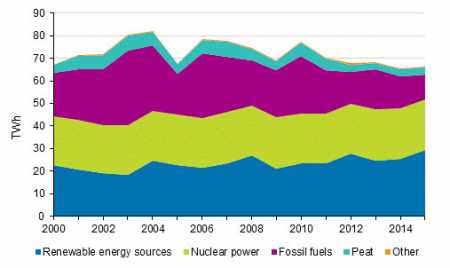|
Thu, 03 Nov, 2016 12:08:11 AM FTimes Report, Nov 3  Electricity generation by energy source in 2000 to 2015. Source: Statistics on production of electricity and heat, Statistics Finland and Electricity statistics, Finnish Energy Industries. The production of electricity in Finland amounted to 66.2 TWh in 2015, which was one per cent higher from the previous year, according to Statistics Finland’s data.
The amount of electricity produced with renewable energy sources was bigger than ever, 29.5 TWh that is 45 per cent of total electricity production. Production of district heat and industrial heat decreased slightly.
The use of fossil fuels diminished, as 29 per cent less hard coal and 15 per cent less natural gas was used than in 2014. The use of peat fell by five per cent as per the data derived from the statistics on the production of electricity and heat.
In 2015, the production of electricity in Finland amounted to 66.2 terawatt hours (TWh) or billion kilowatt hours (kWh). The production went up by one per cent from the year before.
In turn, total electricity consumption went down by one per cent and amounted to 82.5 TWh. Of total electricity consumption, 80 per cent was covered by domestic production and 20 per cent by net imports of electricity from the Nordic countries, Russia and Estonia.
Net imports of electricity went down by nine per cent from the year before. Thirty-two per cent of domestic electricity production was based on combined heat and power production.
Of all electricity production, 29.5 TWh were produced with renewable energy sources, which is the biggest amount ever.
Forty-five per cent of electricity production was covered with renewable energy sources, which is the largest share since the 1970s.
Over one-half of the electricity produced with renewable energy sources was produced with hydro power, nearly one-tenth with wind power and almost all of the remainder with wood-based fuels.
Hydro power was used for producing 16.6 TWh of electricity. More electricity than this has been produced with hydro power only in 2008 and 2012. Seventeen per cent of electricity was produced with fossil fuels, four per cent with peat and 34 per cent with nuclear power.
In 2015, the amount of electricity produced with renewable energy sources increased by 17 per cent from 2014 because the amount of electricity produced with hydro power grew by one-quarter and that produced with wind power more than doubled, the statistics show.
Correspondingly, the amount of electricity produced with wood decreased by four per cent. The amount of electricity produced with renewable energy sources varies by year mainly due to hydro power production, but its trend has been rising in recent years.
The amount of electricity produced with fossil fuels declined by 23 per cent from the year before, as the amount produced with hard coal fell by 35 per cent and that produced with natural gas by 6 per cent.
The use of fossil fuels varies yearly by the use of hard coal in particular, but its trend has been falling in recent years.
The use has, however, decreased as a whole in recent years. The amount of electricity produced with peat decreased by nine per cent from the year before.
The use of peat has annual variation due to the weather dependency of peat production, but its share of the produced electricity has remained at around five per cent in recent years.
The production of district heat totalled 35.0 TWh in 2015. The production went down from the year before. The use of renewable fuels in the production of district heat grew by five per cent from the year before. Nearly one-half of district heat was produced with fossil fuels, whose use fell, however, by 14 per cent from one year ago. Most of district heat was produced with wood fuels and hard coal.
The production of industrial heat was 51.8 TWh in 2015. The production went down slightly from the year before. Over 70 per cent of heat produced for the needs of industry was based on renewable fuels.
Electricity and heat production by production mode in 2015
1) In calculating total primary energy used, hydro power, wind power, solar power and net imports of electricity are made commensurate with fuels according to directly obtained electricity (3.6 PJ/TWh). Total nuclear energy used is calculated at the efficiency ratio of 33 per cent from produced nuclear power (10.91 PJ/TWh). Source: Statistics on production of electricity and heat, Statistics Finland and Electricity statistics, Finnish Energy Industries. More News
|
|
Finland Times
| Tuesday, 18 November, 2025 |

